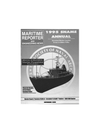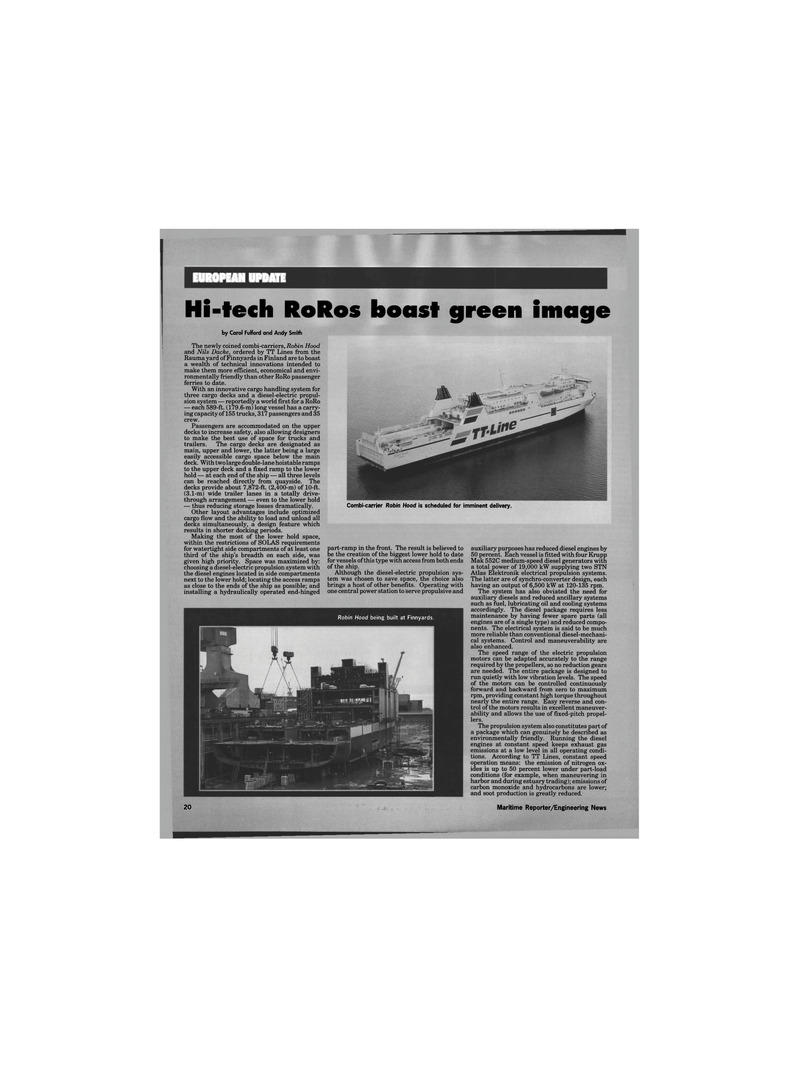
Page 18: of Maritime Reporter Magazine (September 1995)
Read this page in Pdf, Flash or Html5 edition of September 1995 Maritime Reporter Magazine
EUROPEAN UPDATE
Robin Hood being built at Finnyards. 20 Maritime Reporter/Engineering News
Hi-tech RoRos boast green image by Carol Fulford and Andy Smith
The newly coined combi-carriers, Robin Hood and Nils Dacke, ordered by TT Lines from the
Rauma yard of Finnyards in Finland are to boast a wealth of technical innovations intended to make them more efficient, economical and envi- ronmentally friendly than other RoRo passenger ferries to date.
With an innovative cargo handling system for three cargo decks and a diesel-electric propul- sion system — reportedly a world first for a RoRo — each 589-ft. (179.6-m) long vessel has a carry- ing capacity of 155 trucks, 317 passengers and 35 crew.
Passengers are accommodated on the upper decks to increase safety, also allowing designers to make the best use of space for trucks and trailers. The cargo decks are designated as main, upper and lower, the latter being a large easily accessible cargo space below the main deck. With two large double-lane hoistable ramps to the upper deck and a fixed ramp to the lower hold — at each end of the ship — all three levels can be reached directly from quayside. The decks provide about 7,872-ft. (2,400-m) of 10-ft. (3.1-m) wide trailer lanes in a totally drive- through arrangement — even to the lower hold — thus reducing storage losses dramatically.
Other layout advantages include optimized cargo flow and the ability to load and unload all decks simultaneously, a design feature which results in shorter docking periods.
Making the most of the lower hold space, within the restrictions of SOLAS requirements for watertight side compartments of at least one third of the ship's breadth on each side, was given high priority. Space was maximized by: choosing a diesel-electric propulsion system with the diesel engines located in side compartments next to the lower hold; locating the access ramps as close to the ends of the ship as possible; and installing a hydraulically operated end-hinged
Combi-carrier Robin Hood is scheduled for imminent delivery. auxiliary purposes has reduced diesel engines by 50 percent. Each vessel is fitted with four Krupp
Mak 552C medium-speed diesel generators with a total power of 19,000 kW supplying two STN
Atlas Elektronik electrical propulsion systems.
The latter are of synchro-converter design, each having an output of 6,500 kW at 120-135 rpm.
The system has also obviated the need for auxiliary diesels and reduced ancillary systems such as fuel, lubricating oil and cooling systems accordingly. The diesel package requires less maintenance by having fewer spare parts (all engines are of a single type) and reduced compo- nents. The electrical system is said to be much more reliable than conventional diesel-mechani- cal systems. Control and maneuverability are also enhanced.
The speed range of the electric propulsion motors can be adapted accurately to the range required by the propellers, so no reduction gears are needed. The entire package is designed to run quietly with low vibration levels. The speed of the motors can be controlled continuously forward and backward from zero to maximum rpm, providing constant high torque throughout nearly the entire range. Easy reverse and con- trol of the motors results in excellent maneuver- ability and allows the use of fixed-pitch propel- lers.
The propulsion system also constitutes part of a package which can genuinely be described as environmentally friendly. Running the diesel engines at constant speed keeps exhaust gas emissions at a low level in all operating condi- tions. According to TT Lines, constant speed operation means: the emission of nitrogen ox- ides is up to 50 percent lower under part-load conditions (for example, when maneuvering in harbor and during estuary trading); emissions of carbon monoxide and hydrocarbons are lower; and soot production is greatly reduced. part-ramp in the front. The result is believed to be the creation of the biggest lower hold to date for vessels of this type with access from both ends of the ship.
Although the diesel-electric propulsion sys- tem was chosen to save space, the choice also brings a host of other benefits. Operating with one central power station to serve propulsive and

 17
17

 19
19
